Port Celebrates Biggest Investment In 60 Years
New facility is a partnership of city and state, like 'peanut butter and jelly.'
“Milwaukee and Wisconsin are inextricably linked. They belong together, like peanut butter and jelly,” said Mayor Cavalier Johnson Monday morning. “We have a symbiotic relationship between the city and the state. We’re proud to be the economic engine of Wisconsin, and that’s good for Wisconsin, but it’s also good for the entirety of our state.”
City, state, federal and private industry representatives gathered Tuesday to celebrate what port director Jackie Q. Carter said was the word of the day: partnership.
The partners cut the ribbon on The DeLong Company‘s $45 million Agricultural Maritime Export Facility (AMEF), the largest investment in Milwaukee’s port since the Saint Lawrence Seaway opened in the 1950s.
The AMEF will be used to export an ethanol byproduct, dry distillers grain with solubles (DDGS), to Europe and northern Africa, as well as other agricultural products. It’s the first port facility on the Great Lakes capable of handling DDGS, which is moisture-laden and poorly suited for shipping containers. DDGS is used as a nutrient-rich feed to supplement animal diets.
Farmers in Wisconsin and other upper Midwest states will see higher prices for corn as a result of ethanol plants being able to more efficiently export DDGS.
Governor Tony Evers called it a “win, win, win,” for creating jobs in Milwaukee, for supporting the agricultural industry and for boosting the Milwaukee and Wisconsin economies.
“This new development will generate significant economic impact in the years to come,” said Johnson. The Wisconsin Department of Transportation estimates it will create a $63 million annual economic impact across the state.
Wisconsin Department of Transportation Secretary Craig Thompson said the Port of Milwaukee is already the third largest grain export port on the Great Lakes. The new facility, capable of exporting up to 400,000 metric tons, could push the port higher. “This project here is an example of how partnership can make great things happens,” he said.
“Ports like this are critical for maintaining the U.S. as an international leader,” said U.S. Department of Transportation Maritime Administration deputy administrator Tamekia Flack. She noted that measured by weight, 70% of U.S. exports move by water.
The first ship of DDGS already set sail in late June for Ireland and arrived in Belfast a few weeks ago said DeLong president Bo DeLong. A second vessel, this time with soybeans that arrive by rail, is to be loaded in the coming weeks for Europe.
The Jones Island facility, 1711 S. Carferry Dr., accepts deliveries on the east side of the road by either rail or truck. The vehicle is weighed and its contents emptied into a underground bay, where a conveyer system carries it up and over S. Carferry Drive into an approximately 550-foot-long flat storage building. Similar to the initial unloading facility, the storage building also features bays in the floor where DDGS or other grains are pushed and then conveyed, through a New Orleans-built ship loader that swings out over the water, onto a vessel.
Two silos sit at the south end of the storage building for use on smaller loads of grain or other products. The AMEF can store 30,000 metric tons of DDGS or 45,000 metric tons of soybeans. Vessels can carry 7,000 to 22,000 metric tons of DDGS.
DeLong leases the 4.42-acre site from the city. The Clinton-based company is already well-established in the grain shipping and export business. But most of its current exports are loaded into shipping containers, hauled by railcars and ultimately transferred onto massive ocean-going vessels. It operates a flat storage building in Omaha similar to the new one at the port, with the notable difference that it’s for filling shipping containers, not ships.
A 2020 port report said that the project would eliminate 1,600 truck trips annually. Six of Wisconsin’s nine ethanol plants currently truck DDGS past Milwaukee to an intermodal facility in Joliet, IL where standardized shipping containers are available. Ocean-bound products coming from plants and farms outside of Wisconsin are expected to arrive via rail, with the AMEF capable of storing up to 100 hopper cars in its rail yard. A truck, said vice president Pat DeLong, can be emptied in about two minutes. Railcars have approximately three times the capacity of trucks.
The first vessel to be loaded at the facility, the Eroborg, departed with 7,250 metric tons, the equivalent of 330 truck loads, of DDGS.
The facility’s financing is from a mixture of public and private sources. Federal grants covered $15.89 million of the project’s costs, followed by $14 million from DeLong, $9.53 million from the state and $5.7 million from the city. The city will be repaid by the lease, totaling approximately $3.5 million over 30 years, and port tariff fees. Once described as a $31.4 million project, DeLong covered most of the project’s cost increases.
A series of disused buildings were demolished to create the AMEF site.
According to a DeLong representative, DeLong hired Michels Corp. to perform site work on the property, The Scharine Group to construct the conveyance systems and Legacy Building Solutions to build the flat storage building.
The dozens of people in attendance at the event, many sporting DeLong apparel, were treated to tours of the new facility and DDGS-shipping-themed cookies after the press conference.
Photos
Press Conference
Renderings
If you think stories like this are important, become a member of Urban Milwaukee and help support real, independent journalism. Plus you get some cool added benefits.
Eyes on Milwaukee
-
Church, Cupid Partner On Affordable Housing
 Dec 4th, 2023 by Jeramey Jannene
Dec 4th, 2023 by Jeramey Jannene
-
Downtown Building Sells For Nearly Twice Its Assessed Value
 Nov 12th, 2023 by Jeramey Jannene
Nov 12th, 2023 by Jeramey Jannene
-
Immigration Office Moving To 310W Building
 Oct 25th, 2023 by Jeramey Jannene
Oct 25th, 2023 by Jeramey Jannene


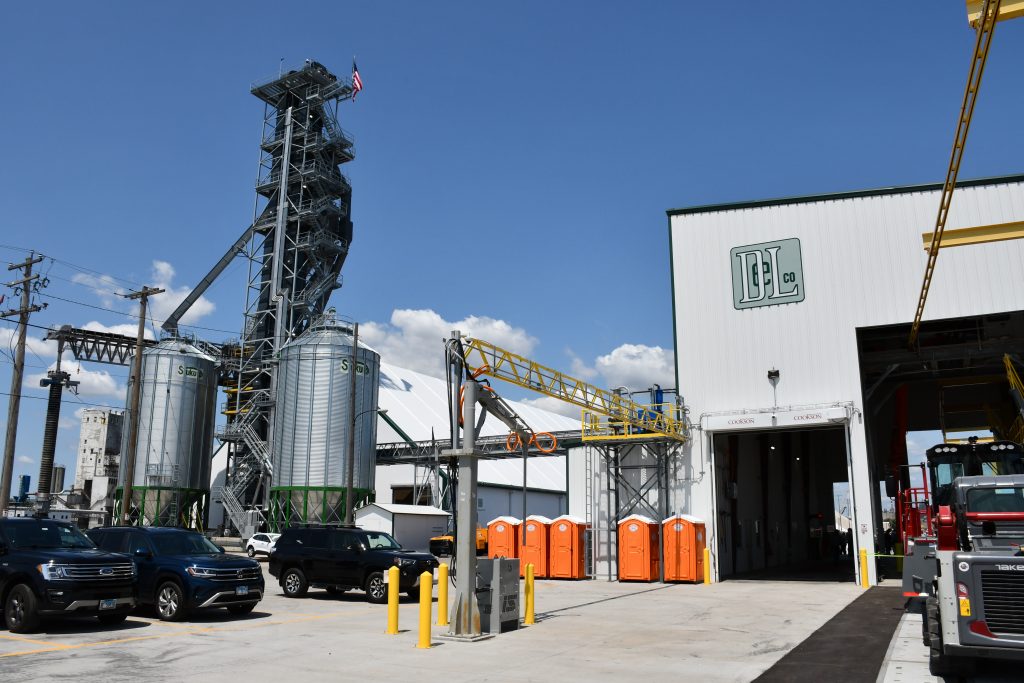
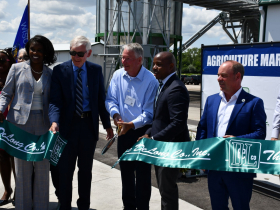
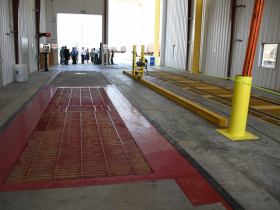

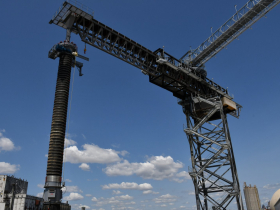
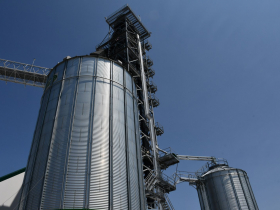
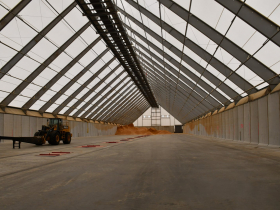
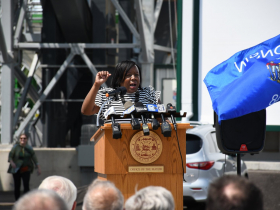
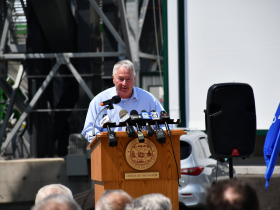
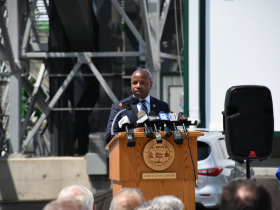
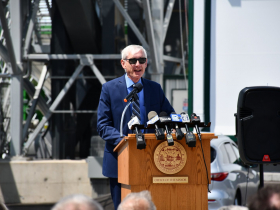
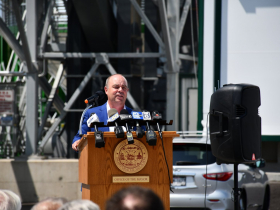
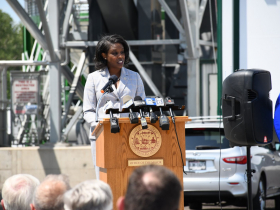
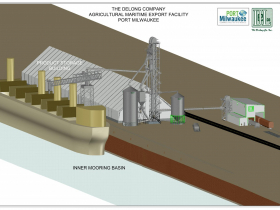
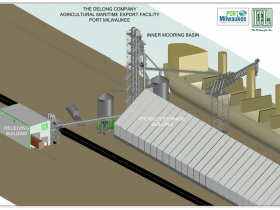
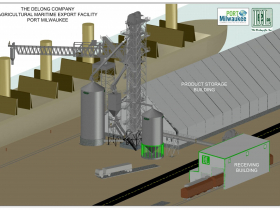


















Outstanding, and another accomplishment that puts our port city on the national & world stages!
I anxiously await much-needed Port MKE improvements on the tourism/cruise ship business end as well. Kudos to all involved!
Thanks for covering this.